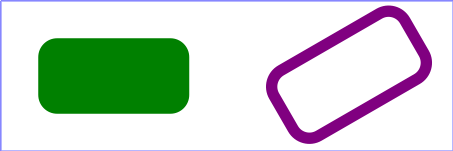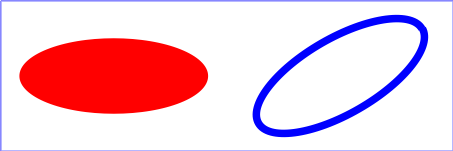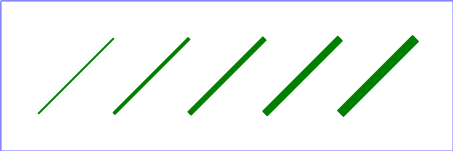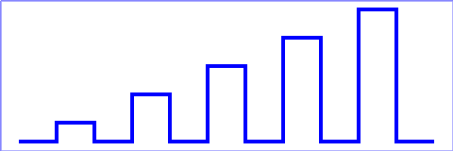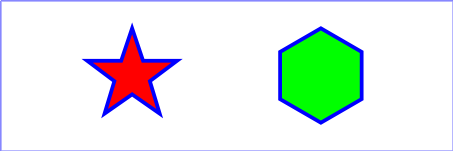9 Basic Shapes
Contents
9.1 Introduction
SVG contains the following set of basic shape elements:
- rectangles (including optional rounded corners), created with the 'rect' element,
- circles, created with the 'circle' element,
- ellipses, created with the 'ellipse' element,
- straight lines, created with the 'line' element,
- polylines, created with the 'polyline' element, and
- polygons, created with the 'polygon' element.
Mathematically, these shape elements are equivalent to a 'path' element that would
construct the same shape. The basic shapes may be stroked,
and filled. All of the properties available
for 'path' elements also apply to
the basic shapes.
9.2 The 'rect'
element
The 'rect' element defines
a rectangle which is axis-aligned with the current user coordinate
system. Rounded rectangles can be achieved by setting
appropriate values for attributes 'rx' and 'ry'.
If a properly specified value is provided for 'rx' but not for 'ry', then the user agent must process
the 'rect' element with the
effective value for 'ry' as equal to 'rx'. If a properly specified value
is provided for 'ry' but not for 'rx', then the user agent must process
the 'rect' element with the
effective value for 'rx' as equal to 'ry'. If neither 'rx' nor 'ry' has a properly specified value,
then the user agent must process the 'rect' element as if no
rounding had been specified, resulting in square corners. If 'rx' is greater than half of the
width of the rectangle, then the user agent must process the 'rect' element with the
effective value for 'rx' as half of the width of the
rectangle. If 'ry' is greater than half of the
height of the rectangle, then the user agent must process the 'rect' element with the
effective value for 'ry' as half of the height of the
rectangle.
A 'rect' element, taking its rounded
corners into account, must be rendered in a way that produces the
same result as if the following
outline were specified instead
(note: all coordinate and length values are first converted
into user space coordinates according to Units):
- Perform an absolute moveto operation to location (x+rx,y), where x and y are the values of the
'rect' element's 'x'
and 'y' attribute converted to user space, and rx and ry are the effective values of the
'rx' and 'ry' attributes converted to user space.
- Perform an absolute horizontal lineto operation to location (x+width-rx,y), where width is the 'rect' element's 'width' attribute converted to user space.
- Perform an absolute elliptical arc operation to coordinate (x+width,y+ry), where the effective values for the 'rx' and 'ry' attributes on the
'rect' element converted to user space are used as the semimajor and semiminor axis, respectively, zero x-axis-rotation, a clockwise sweep direction and choosing the smaller arc sweep.
- Perform an absolute vertical lineto operation to location (x+width,y+height-ry), where height is the 'rect' element's 'height' attribute converted to user space.
- Perform an absolute elliptical arc operation to coordinate (x+width-rx,y+height).
- Perform an absolute horizontal lineto operation to location (x+rx,y+height).
- Perform an absolute elliptical arc operation to coordinate (x,y+height-ry).
- Perform an absolute vertical lineto operation to location (x,y+ry).
- Perform an absolute elliptical arc operation to coordinate (x+rx,y).
- Perform a closepath (z) to the coordinate specified in the original moveto operation.
In case the 'rx' and 'ry' attributes are not specified or set to a value of zero, the elliptical arc commands should be omitted.
Example 09_01 shows a
rectangle with sharp corners. The 'rect' element is filled with
yellow and stroked with navy.
<?xml version="1.0"?>
<svg width="12cm" height="4cm" viewBox="0 0 1200 400"
xmlns="http://www.w3.org/2000/svg" version="1.2" baseProfile="tiny">
<desc>Example rect01 - rectangle with sharp corners</desc>
<!-- Show outline of canvas using 'rect' element -->
<rect x="1" y="1" width="1198" height="398"
fill="none" stroke="blue" stroke-width="2"/>
<rect x="400" y="100" width="400" height="200"
fill="yellow" stroke="navy" stroke-width="10" />
</svg>
Example 09_02 shows two
rounded rectangles. The 'rx' specifies how to round the
corners of the rectangles. Note that since no value has been
specified for the 'ry' attribute, it will be assigned
the same value as the 'rx' attribute.
<?xml version="1.0"?>
<svg width="12cm" height="4cm" viewBox="0 0 1200 400"
xmlns="http://www.w3.org/2000/svg" version="1.2" baseProfile="tiny">
<desc>Example rect02 - rounded rectangles</desc>
<!-- Show outline of canvas using 'rect' element -->
<rect x="1" y="1" width="1198" height="398"
fill="none" stroke="blue" stroke-width="2"/>
<rect x="100" y="100" width="400" height="200" rx="50"
fill="green" />
<g transform="translate(700 210) rotate(-30)">
<rect x="0" y="0" width="400" height="200" rx="50"
fill="none" stroke="purple" stroke-width="30" />
</g>
</svg>
9.3 The 'circle'
element
The 'circle' element
defines a circle based on a center point and a radius.
Within the current user coordinate system,
stroking operations on a circle begin at the point (cx+r,cy)
and then proceed through the points (cx,cy+r), (cx-r,cy), (cx,cy-r) and finally back to (cx+r,cy).
For stroking operations, there is only one line segment
which has its beginning joined to its end.
Example circle01 consists
of a 'circle' element that is
filled with red and stroked with blue.
<?xml version="1.0"?>
<svg width="12cm" height="4cm" viewBox="0 0 1200 400"
xmlns="http://www.w3.org/2000/svg" version="1.2" baseProfile="tiny">
<desc>Example circle01 - circle filled with red and stroked with blue</desc>
<!-- Show outline of canvas using 'rect' element -->
<rect x="1" y="1" width="1198" height="398"
fill="none" stroke="blue" stroke-width="2"/>
<circle cx="600" cy="200" r="100"
fill="red" stroke="blue" stroke-width="10" />
</svg>
9.4 The 'ellipse'
element
The 'ellipse' element
defines an ellipse which is axis-aligned with the current user coordinate
system based on a center point and two radii.
Within the current user coordinate system,
stroking operations on a ellipse begin at the point (cx+rx,cy)
and then proceed through the points (cx,cy+ry), (cx-rx,cy), (cx,cy-ry) and finally back to (cx+rx,cy).
For stroking operations, there is only one line segment
which has its beginning joined to its end.
Example 09_04 below
specifies the coordinates of the two ellipses in the
user coordinate system established by the 'viewBox' attribute on the 'svg' element and the 'transform' attribute on the 'g' and 'ellipse' elements. Both
ellipses use the lacuna value of zero for the 'cx' and 'cy' attributes (the center of the
ellipse). The second ellipse is rotated.
<?xml version="1.0"?>
<svg width="12cm" height="4cm" viewBox="0 0 1200 400"
xmlns="http://www.w3.org/2000/svg" version="1.2" baseProfile="tiny">
<desc>Example ellipse01 - examples of ellipses</desc>
<!-- Show outline of canvas using 'rect' element -->
<rect x="1" y="1" width="1198" height="398"
fill="none" stroke="blue" stroke-width="2" />
<g transform="translate(300 200)">
<ellipse rx="250" ry="100"
fill="red" />
</g>
<ellipse transform="translate(900 200) rotate(-30)"
rx="250" ry="100"
fill="none" stroke="blue" stroke-width="20" />
</svg>
9.5 The 'line'
element
The 'line' element defines
a line segment that starts at one point and ends at
another.
A 'line' element must be rendered in a way that produces the
same result as if the following
path were specified instead
(note: all coordinate and length values are first converted
into user space coordinates according to Units):
- Perform an absolute moveto operation
to absolute location (x1,y1), where
x1 and y1 are the values of the 'line' element's 'x1' and 'y1' attributes converted to
user space, respectively.
- Perform an absolute lineto operation
to absolute location (x2,y2), where
x2 and y2 are the values of the 'line' element's 'x2' and 'y2' attributes converted to
user space, respectively.
Because 'line' elements are single
lines and thus are geometrically one-dimensional, they have no
interior; thus, 'line' elements are never
filled (see the 'fill' property).
Example 09_05 below
specifies the coordinates of the five lines in the
user coordinate system established by the 'viewBox' attribute on the 'svg' element. The lines have
different thicknesses.
<?xml version="1.0"?>
<svg width="12cm" height="4cm" viewBox="0 0 1200 400"
xmlns="http://www.w3.org/2000/svg" version="1.2" baseProfile="tiny">
<desc>Example line01 - lines expressed in user coordinates</desc>
<!-- Show outline of canvas using 'rect' element -->
<rect x="1" y="1" width="1198" height="398"
fill="none" stroke="blue" stroke-width="2" />
<g stroke="green" >
<line x1="100" y1="300" x2="300" y2="100"
stroke-width="5" />
<line x1="300" y1="300" x2="500" y2="100"
stroke-width="10" />
<line x1="500" y1="300" x2="700" y2="100"
stroke-width="15" />
<line x1="700" y1="300" x2="900" y2="100"
stroke-width="20" />
<line x1="900" y1="300" x2="1100" y2="100"
stroke-width="25" />
</g>
</svg>
9.6 The 'polyline'
element
The 'polyline' element
defines a set of connected straight line segments. Typically,
'polyline' elements define
open shapes.
If an odd number of coordinates is provided, then the
element is treated as if the attribute had not been specified.
A 'polyline' element must be rendered in a way that produces the
same result as if the following
path were specified instead:
- Perform an absolute moveto operation
to the first coordinate pair in the list of points.
- For each subsequent coordinate pair, perform an absolute
lineto
operation to that coordinate pair.
Example 09_06 below
specifies a polyline in the user coordinate system established
by the 'viewBox' attribute on the 'svg' element.
<?xml version="1.0"?>
<svg width="12cm" height="4cm" viewBox="0 0 1200 400"
xmlns="http://www.w3.org/2000/svg" version="1.2" baseProfile="tiny">
<desc>Example polyline01 - increasingly larger bars</desc>
<!-- Show outline of canvas using 'rect' element -->
<rect x="1" y="1" width="1198" height="398"
fill="none" stroke="blue" stroke-width="2" />
<polyline fill="none" stroke="blue" stroke-width="10"
points="50,375
150,375 150,325 250,325 250,375
350,375 350,250 450,250 450,375
550,375 550,175 650,175 650,375
750,375 750,100 850,100 850,375
950,375 950,25 1050,25 1050,375
1150,375" />
</svg>9.7 The 'polygon'
element
The 'polygon' element
defines a closed shape consisting of a set of connected
straight line segments.
If an odd number of coordinates is provided in the 'points'
attribute, then it is treated as an unsupported value.
A 'polygon' element must be rendered in a way that produces the
same result as if the following
path were specified instead:
- Perform an absolute moveto operation
to the first coordinate pair in the list of points.
- For each subsequent coordinate pair, perform an absolute
lineto
operation to that coordinate pair.
- Perform a closepath
command.
Example 09_07 below
specifies two polygons (a star and a hexagon) in the
user coordinate system established by the 'viewBox' attribute on the 'svg' element.
<?xml version="1.0"?>
<svg width="12cm" height="4cm" viewBox="0 0 1200 400"
xmlns="http://www.w3.org/2000/svg" version="1.2" baseProfile="tiny">
<desc>Example polygon01 - star and hexagon</desc>
<!-- Show outline of canvas using 'rect' element -->
<rect x="1" y="1" width="1198" height="398"
fill="none" stroke="blue" stroke-width="2" />
<polygon fill="red" stroke="blue" stroke-width="10"
points="350,75 379,161 469,161 397,215
423,301 350,250 277,301 303,215
231,161 321,161" />
<polygon fill="lime" stroke="blue" stroke-width="10"
points="850,75 958,137.5 958,262.5
850,325 742,262.6 742,137.5" />
</svg>
9.7.1 The grammar for points specifications in 'polyline' and 'polygon' elements
The following is an EBNF grammar for <points-data>
values on 'polyline'
and 'polygon' elements [EBNF]:
points-data:
wsp* coordinate-pairs? wsp*
coordinate-pairs:
coordinate-pair
| coordinate-pair comma-wsp coordinate-pairs
coordinate-pair:
coordinate comma-wsp coordinate
coordinate:
number
number:
sign? integer-constant
| sign? floating-point-constant
comma-wsp:
(wsp+ comma? wsp*) | (comma wsp*)
comma:
","
integer-constant:
digit-sequence
floating-point-constant:
fractional-constant exponent?
| digit-sequence exponent
fractional-constant:
digit-sequence? "." digit-sequence
| digit-sequence "."
exponent:
( "e" | "E" ) sign? digit-sequence
sign:
"+" | "-"
digit-sequence:
digit
| digit digit-sequence
digit:
"0" | "1" | "2" | "3" | "4" | "5" | "6" | "7" | "8" | "9"
wsp:
(#x20 | #x9 | #xD | #xA)+

